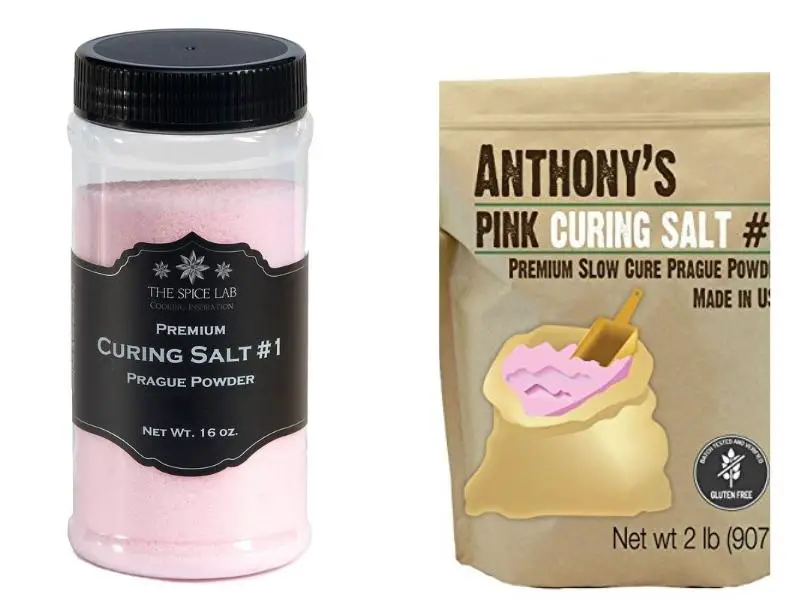- Curing Salt is known for Sodium Nitrite, Pink Salt, Insta Cure No. 1, DQ Curing Salt, and celery salt. Curing Salt is used for curing fish, sausage, bacon, and other meats (not poultry).
- It prevents botulism. Cure #1 is the only product with nitrates in it, so keep your eyes open for this listing when you shop.
- Curing Salt can also be purchased online from Pickle Packers Paradise Site. Some people refer to pickling Salt as curing Salt because of its sodium nitrate content, but this is not true again.
- You can check here if there are any FDA rules around curing salts with meat for your state.
- Curing Salt is only needed if you will be making any of the above meat products, so unless you plan on adding this step to your preservation food supplies, there is no need for this ingredient.
Where To Find Curing Salt In Grocery Store?
If you can’t find it, ask a produce manager, and they should be able to help you locate it in the store. If all else fails, try Amazon: Pickle Packers Paradise Site.
Does Walmart have to cure Salt?
No, WALMARTS does not carry any cure or iodized Salt at their stores, but there may be other specialty items such as “pink salt” ( AKA flaky rock), which could contain nitrite.
Walmart also does not carry any of the makings for home-cured meats like bacon.
There may be smaller chains in your area that may stock curing Salt, so it’s best to check around before picking up a pound of cure from Amazon or another online source.
What can I use instead of curing Salt?
You CAN use table salt, but many say it doesn’t have good enough concentration to do its job, but if you’re in a pinch and can’t find anything else, go ahead and give it a try.
You might want to keep your eyes open for other sources that may have curing salts available somewhere locally in stores or for sale online.
Is Himalayan Salt Same as Curing Salt?
No. You can search for Himalayan Salt and find a few places that sell this type of Salt in bulk, but keep in mind it will be WAY more expensive than curing salts.
The only difference between the two is the color. Curing Salt is made from regular table salt, producing a pink or red hue when pure sodium nitrite is added during processing – not Himalayan Pink Salt.
Is Pickling Salt the Same as Curing Salt?
Pickling salt has nothing to do with smoking meats, FWIW. You may indeed see pickling salt referred to as cure #1 by some sources, but again they are different, so don’t get them confused.
Can I use Table Salt Instead of Curing Salt?
No. Table salt has iodine, so it is not safe to use for any curing process. Iodine inhibits the effectiveness of sodium nitrite, which you need over a certain concentration over a long period ( sometimes months).
The best way to find out what will work in your area and how to cure meat at home is to email or call some local butcher shops and ask if they carry curing Salt locally.
It’s also good practice to ask them how long they recommend letting the product sit before cooking for safety reasons.
You can also lookup old fashioned “dry-cured” meats like prosciutto online and get some tips on what types of Salt they used.
How do you make curing Salt at home?
This is tricky because it’s involved, but some people have done this before and shared how they did it online.
As with any new experiment, take caution, do your research, gather information from various sources, then finally try it out yourself under the supervision of an adult or someone who has experience in these matters.
Making anything like this at home can be very dangerous if not done correctly, so please don’t try to make your curing salts unless you are fully prepared.
How do you use Salt to cure meat at home?
Adding nitrites (sodium nitrite) or nitrates (saltpeter) to meat products to preserve them is an old process dating back hundreds of years ago when there were no refrigeration techniques available.
It’s still used today in many products like bacon, corned beef, sausages, deli counter meats, etc.
If you visit any food processing or butchering website, you will see how serious this process is, all the measurements and precautions taken to make sure it’s done safely.
Conclusion:
Here’s a good analogy to remember when trying to figure out what Salt you should use for making or curing meat products at home. It will help you make the right choice.

